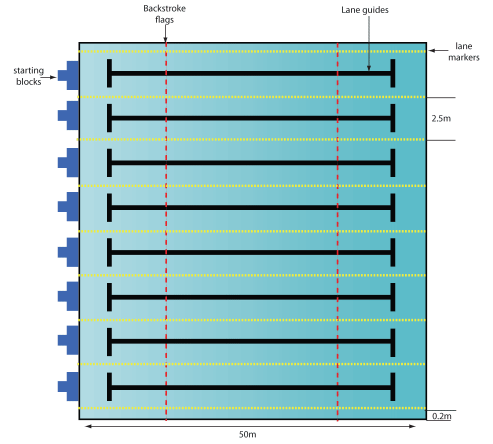Introduction
The aquatic sport of swimming is based on the human act of swimming, that is, locomotion in water by self propulsion and usually with the goal to complete a given distance in the shortest time. There are also swimming competitions based on endurance or precedence rather than speed, such as crossing the English Channel or some other stretching of open water. As a sport, swimming is usually distinguished from other acquatic sports (such as diving, synchronized swimming and water polo) that involve the act of swimming but where the goal is neither speed nor endurance.
Pool
Standard pools are 50m or 25m in length. Lanes are at least 2.5m wide with two spaces of at least 0.2m outside of the first and last lanes.In Olympic or World Championships, pools are 50m long (except for World Championship 25m) with a minimum of eight racing lanes. There are two spaces 2.5m wide outside the eight lanes.
If the swimming pool and diving pool are in the same area, they must be 5m apart from each other.
A minimum depth of 1.35m, extending from 1m?6m from the end wall is required for pools with starting blocks. A minimum depth of 1m is required for pools. For Olympic and World Championships the minimum depth is 2m.
Modalities
There are many modalities of swimming competitions, including- Butterfly or fly: the course must be completed entirely in the butterfly style, in which the swimmer brings both hands over their head close to the water, breathing forward, "Dolphin kicking" (undulating) with both feet together in sequence, two kicks per arm stroke. All end walls must be touched with two hands, and the swimmer will be disqualified if his/her arms do not clear the water at the same time. Typical distances include 25(8&U), 50, 100, 200.
- Backstroke back: competitors must swim in the backstroke style, which is similar to the front crawl, except your back. The players kick by alternating both feet, pulleach arm one at a time and look straight up. At the end walls, flip turns are permitted (the swimmer is to turn on to his/her front before performing the turn), and a two-hand touch is not necessary. Typical distances include 25(8&U), 50, 100, 200.
- Breaststroke or breast: competitors must swim in the breaststroke style where the swimmer kicks legs out (much like a frog, but more whip like, it is important to keep the kick narrorw), scoops the water in towards the chest with his or her hands and then thrusts the hands out in front just before the kick is repeated. One underwater "pull-out" is permitted at the start and after every end wall, with, in order: streamline glide, one fully extended pull, one dolphin kick (must be timed precisely with pull), one breaststroke kick, and all while not breathing. The two hands must touch the wall simultaneously at every turn. After the 2004 Olympics in Athens, Greece, thanks to Kosuke Kitajima, there was an adjustment to the underwater "pull-out". The new rule states that you can also do a single downward dolphin kick (upward is not permitted). Kosuke Kitajima was the first breaststroke swimmer to perform such "pull-out". Typical distances include 25(8&U), 50, 100, 200.
- Freestyle of free: competitors are free to use any stroke they wish. Most select the front crawl, as it is both the fastest and most efficient. The front crawl is a stroke where the swimmer breathes to the side, kicks by alternating both legs and pulls with each arm at different times. Flip/tumble turns are legal. Variants include free relays, in which four team members swim an equal distance of freestyle; when one member touches the end wall, the next can dive off the block. Typical distances are 25(8&U), 50, 100, 200, 400, 500, 800, 1000, 1500, and 1650.
- Individual medley or IM: each swimmer must complete one quarter of the full distance in each of the three competition styles (butterfly, backstroke, breaststroke) and one part in free style. Open turns are required in the switch from one style to another, but flip turns or bucket turns can be made during backstroke and freestyle. Each part must be completed in its style before moving on to the next style. Variations include medley relays, in which four team members each swim one part (in the order of backstroke, breaststroke, butterfly and free). The full distance is typically 100, 200, or 400 units.
